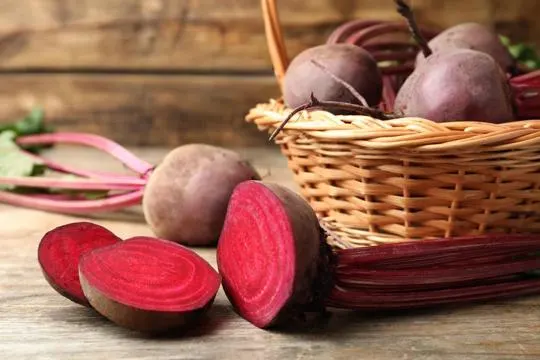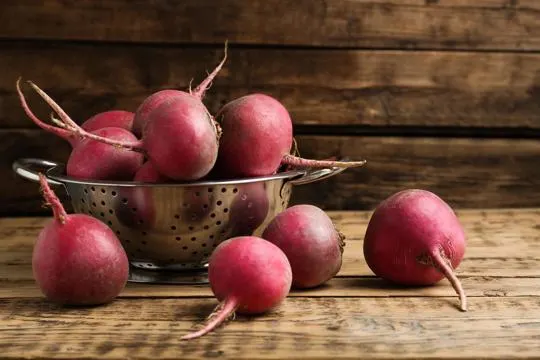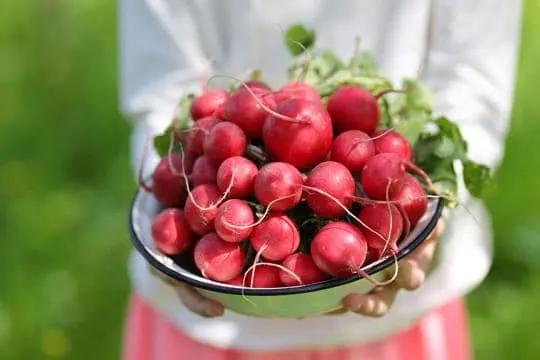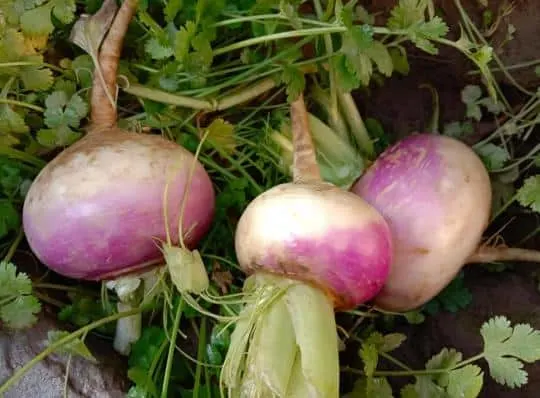Summary of key points
The main difference between radishes, beets, and turnips is their appearance, taste, and uses in cooking. While all three are root vegetables, radishes are typically small and round with a bright red or pink skin, beets have a larger bulbous shape with dark red or purple skin, and turnips are larger in size with white or yellow skin.
In terms of taste, radishes have a sharp and peppery flavor, while beets are sweet and earthy, and turnips have a milder taste with a slight bitter edge. Each vegetable can be cooked in various ways, but they also have unique properties – for example, radishes are often eaten raw in salads, while beets are commonly roasted or pickled.
Ever stood in the produce aisle, scratching your head over root vegetables? We have.
Radishes, beets, and turnips. All crunchy, all earthy, and yes, all different.
Radishes pack a peppery punch. Beets bring the sweet. Turnips? They’re somewhere in the middle.
We’ve all had that moment. Picking one, hoping for the best.
Today, we’re breaking it down. No more vegetable confusion.
In our kitchens, radishes spice up salads. Beets color our smoothies. Turnips make us wonder why we chose them.
It’s time to learn what sets them apart. And maybe, laugh at our past mix-ups.
What are Radishes?

Radishes are tiny root veggies that come from the Brassicaceae family.
They’re famous for their crunchy texture, peppery flavor, and bright colors.
Radishes have different shapes and sizes, from small round ones to lengthy cylindrical varieties.
Usually, they’re eaten raw in salads or as a topping for dishes.
Plus, they’re full of vitamins C and K, potassium, and calcium.
With their special taste and versatility in recipes, radishes bring a new element to any food.
A cool thing about radishes is their fast growing time.
Unlike some other root vegetables, they can be harvested in just a few weeks.
They’re low in calories and high in fiber, making them a healthy snack.
Another fascinating fact is that there are many kinds of radishes.
Even though the red radish is common, there are also white, pink, purple, and even black types.
Each kind has its own flavor, from mild to spicy.
This diversity enables chefs and home cooks to try different flavors and textures in their recipes.
Plus, radishes have been used medicinally for centuries.
Ancient medicine included radish extracts or juices to cure digestive problems, like indigestion and constipation.
Some research even suggests that compounds in radishes may have anti-inflammatory properties.
In conclusion, radishes are adaptable root veggies with a unique flavor from mild to spicy.
They offer lots of health benefits and can be enjoyed raw or cooked in various dishes.
With their rapid growth and many varieties, these vibrant veggies will add both color and flavor to any plate.
What are Beets?

Beets boast a rainbow of colors – from deep crimson to golden yellow.
Not only are they eye-catching, but they’re good for you too.
Low in fat and calories, yet loaded with essential vitamins and minerals.
Plus, their dietary nitrates have been linked to improved athletic performance and cardiovascular health.
And the antioxidants? They have impressive anti-inflammatory properties.
But wait, there’s more.
Not just the root, but also the greens on top are healthy.
Beet greens are an excellent source of vitamin K.
This helps with blood clot formation and bone health.
So, you should definitely make use of both the root and greens.
Beets are so versatile.
Use them in roasted beet salads or refreshing juice blends.
Next time you’re at the grocery store or farmer’s market, give beets a try.
What are Turnips?

Turnips are a root veggie.
They have a round shape and a crispy texture.
They are part of the Brassicaceae fam, which includes cabbage, broccoli, and mustard.
Skin color can be white or purple.
The flesh is white to yellow.
The taste is mildly sweet and tangy.
Turnips can be enjoyed raw in salads, pickled, roasted, or in soups and stews.
They are very nutritious.
High in Vitamins C and K, plus fiber and antioxidants.
Perfect for a healthy diet.
Mashed with butter or sliced in a stir-fry, turnips add flavor and variety to meals.
Differences Between Radish, Beet, and Turnip

Radish, beet, and turnip may appear alike, however they possess individual features.
Radish is renowned for its crunchy texture and pungent flavor.
Beet, in contrast, has a sweet taste and delicate texture.
And the slightly bitter taste of turnip is somewhere in-between.
Appearance and Shape
Radish, beet, and turnip may look similar, but take a closer look and you’ll see they’re distinct.
Radish is small and round with a red or white color and smooth texture.
Beet has a bulbous shape with a deep purple hue.
Its size is medium – perfect for cooking.
And turnip? It’s bigger, with a flattened shape and a creamy-white or light yellow complexion.
Radishes have a glossy skin.
But beets are glossy on the inside when sliced open.
Turnips, however, have an earthy exterior skin.
These root veggies differ in texture too.
Radishes are crisp, great raw or pickled.
Beets are smooth and tender.
And turnips are dense due to their starch content.
Understanding the differences in shape and appearance reveals the diverse range of flavors and textures these root veggies bring to the kitchen.
So, explore them in your next meal – whether it’s radish’s petite roundness, beet’s elegant bulbs, or turnip’s robust size.
Flavor Profile
Radishes, beets, and turnips look alike, but have distinct tastes.
Crisp and peppery, radishes bring a refreshing zing to salads and sandwiches.
Beets are sweet and earthy, good for roasting or making soups.
Turnips have a mildly sweet and bitter flavour, great for mashing or stir-frying.
Young radishes are vibrant and spicy.
Older ones taste more mellow.
The level of sweetness in beets depends on their type – golden beets are milder than red.
When cooked, turnips have a blend of sweet and bitter, great for stews or roasted veggies.
Radishes’ crunch pairs well with softer ingredients, like slaws or tacos.
Beets are tender, cooked or raw.
Turnips can be firm raw, or tender cooked.
Nutritional Differences
Comparing radish, beet, and turnip? Consider their nutritional differences.
Each offers unique health benefits.
Radishes are low-cal and high in fiber.
Great for weight management and digestive health.
Plus, they contain vitamin C, potassium, and folate.
Beets have vibrant color from betalains.
These compounds have antioxidant properties.
Also a good source of folate, manganese, and potassium.
Turnips have a distinctive flavor and vitamins A, C, K, calcium, and potassium.
Turnip greens provide additional vitamins and minerals.
All three root veggies offer different flavors and health benefits due to their unique nutritional profiles.
Incorporating them into your diet supports overall well-being.
Culinary Uses
Radish, beet, and turnip are veggies with loads of flavor.
They’ve been used in many cuisines for centuries.
Chefs and home cooks love them for their unique tastes and textures.
Radishes are crunchy and spicy.
Enjoy them raw in salads or pickle them for tanginess.
Or, sautée or roast them to soften the sharpness.
Radish greens can be cooked like spinach or added to soups.
Beets have a vibrant color and earthy taste.
Roast or boil them to bring out their sweetness.
Juice, puree into soups, or grate into cakes for natural sweetness.
Turnips are similar to potatoes but with a pepperiness.
Mash or roast them.
Turnip greens are nutritious and can be sautéed or added to stews.
Combining these root veggies makes meals extra special.
Pickle them as a medley or roast with other veggies for a hearty side dish.
Radishes – crunchy and spicy.
Beets – earthiness and sweetness.
Turnips – versatility and pepperiness.
Experiment with these three roots to make amazing dishes.
Similarities Between Radish, Beet, and Turnip

Radish, beet, and turnip look alike.
But they’re not the same.
They’re vibrant and crunchy–perfect for adding a punch to dishes.
Plus, they offer a slight peppery flavor that can range from mild to intense.
And they’re full of vitamins and minerals too.
Radishes are small and red.
Beets come in many colors–purple, yellow, and striped.
Turnips are bulbous and white-skinned.
But all three have firm flesh, good for cooking or eating raw.
Radishes are great in salads or as a garnish.
Roast or boil beets for borscht or salads.
Turnips are perfect for stews and soups–they absorb flavors when cooked.
Plus, their greens are edible.
Radish greens are great sautéed.
Beet greens are like radish greens.
And turnip greens have a bitter taste.
So, although radish, beet, and turnip share similarities, they have their own unique characteristics.
Enjoy experimenting with them in your cooking.
Health Benefits and Uses of Radish, Beet, and Turnip
Radish, beet, and turnip are root veggies that offer health advantages and have multiple uses.
They are all root vegetables that belong to the Brassicaceae family and have distinct flavors, colors, and textures.
Radishes are crunchy and sharp-tasting.
They are low in calories and packed with nutrients such as vitamin C, potassium, and fiber.
Salads are a great way to add radish for its refreshing crunch and flavor.
Beets are sweet and earthy.
They have betalains which are antioxidants linked to health benefits like reduced inflammation and better heart health.
You can roast, steam, or juice beets to make dishes more exciting.
Turnips have a milder flavor than radishes and beets.
They are a great source of vitamin C and dietary fiber.
Enjoy them raw or cooked by roasting, stewing, or pureeing.
Turnips can give soups, stews, and stir-fried dishes a unique taste.
Remember, radishes have glucosinolates which may have anticancer effects.
Also, beets contain nitrates that boost blood flow and can enhance exercise performance.
How to Incorporate Radish, Beet, and Turnip in Cooking?
Radish, beet, and turnip can give a special flavor to your cooking.
Here are some tips to employ them imaginatively:
- Salads: Slice them thinly and mix with greens. Radishes’ crispness goes well with beets’ sweetness, plus turnips’ earthy flavors add strength.
- Roasting: Preheat oven to 400°F (200°C). Peel and chop. Toss with olive oil, salt, and pepper. Put on a baking sheet and roast for 25-30 mins.
- Puree: Steam them until soft, then blend with garlic, salt, pepper, and cream/butter. Perfect accompaniment to roasted meat/fish.
- Stir-fry: Heat oil in pan over medium-high heat. Add sliced radishes, grated beets, cubed turnips, and seasonings. Fry for 5-7 mins until crunchy but cooked.
Besides flavors, they have nutritional value.
Radishes are high in vitamin C and fiber; beets contain iron and folate; turnips provide vitamin K and antioxidants.
By using these techniques to add radish, beet, and turnip, you can boost the taste of your dishes and reap their nutrition.
Conclusion
After researching the various differences between a radish, beet, and turnip, we can conclude that it all comes down to personal preference.
All three vegetables have similarities in terms of their natural bitterness and earthy flavor profile, but the variances are in the texture.
Radishes bring a delightful snap when crunchy, while beets offer an enjoyable softness or sweetness.
And finally, turnips provide a pleasingly mild flavor with a smooth texture.
So if you’re ever stuck deciding which one might work best for a recipe or dish, remind yourself of the distinct qualities each offer to see what might be best overall.
There’s nothing quite like biting into a freshly pickled vegetable or discovering recent ways of revamping an old favorite recipe with these instructions as your guide – experimentation is always permitted too.
Thanks for reading and have fun in the kitchen.

Leave a comment